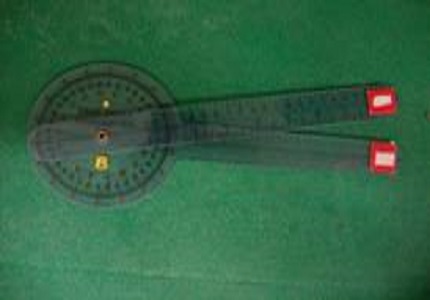Reliability of goniometry to determine the hip range of motion
Abstract
Purpose: The purpose of this study was to determine the intra-tester and inter-tester reliability of goniometric measurements when measuring the hip joint. Also this study aimed at determining the validity and reliability of goniometry as a tool to diagnose hip pathologies and record the hip range of motion. Materials and
Methods: Fifteen recreationally active male participants (age 26.67 + 4.84 years) and five physiotherapists took part in this study. Measurement values were got by performing passive range of motion on each participant. Angles derived from the goniometry measurements were compared to the known standard angles of the hip range of motion. An intervention was also performed to see the difference in measurement values after sensitising the physiotherapists to methods of performing goniometry accurately and get precise and valid results. Intraclass coefficient correlations (ICC) were performed to see the correlation between inter-tester and intra-tester measurements. The Root mean square error (RMSE) was used to determine the accuracy of goniometric values got by physiotherapists after the intervention. The Root mean square error of goniometric measurements of the hip range of motion was calculated in reference to standard values (RMSE- 8-18).
Results: The left sided hip internal rotation showed the highest deviation from the standard (RMSE- 16.20). Both sided hip extensions were the least deviated from standards (left- 8.00; right- 8.49). The intraclass coefficient correlations in intra-tester values were persistently higher than 0.70 whereas in the inter-tester setting, the values were less than 0.70.
Conclusion: The intra-tester reliability was higher than the inter-tester reliability in our study. We observed that the goniometric measurement values were most reliable for hip extension and least for internal and external rotation, followed by hip abduction and adduction.
Downloads
References
2. Gore RM, Rogers LF, Bowerman J, Suker J, Compere CL. Osseous manifestations of elbow stress associated with sports activities. American Journal of Roentgenology. 1980 May 1;134(5):971-7.
3. Kaufman KR, Brodine SK, Shaffer RA, Johnson CW, Cullison TR. The effect of foot structure and range of motion on musculoskeletal overuse injuries. Am J Sports Med. 1999 Sep-Oct;27(5):585-93. [PubMed]
4. Philippon M, Schenker M, Briggs K, Kuppersmith D. Femoroacetabular impingement in 45 professional athletes: associated pathologies and return to sport following arthroscopic decompression. Knee Surgery, Sports Traumatology, Arthroscopy. 2007 Jul 1;15(7):908-14.
5. Shindle MK, Voos JE, Heyworth BE, Mintz DN, Moya LE, Buly RL, Kelly BT. Hip arthroscopy in the athletic patient: current techniques and spectrum of disease. JBJS. 2007 Oct 1;89(suppl_3):29-43.
6. Jaberi FM, Parvizi J. Hip pain in young adults: femoroacetabular impingement. The Journal of arthroplasty. 2007 Oct 31;22(7):37-42. [PubMed]
7. Brian P, Bernard S, Flemming D. Femoroacetabular impingement: screening and definitive imaging. Semin Roentgenol. 2010 Oct;45(4):228-37. doi: 10.1053/j.ro.2009.12.006.
8. Keogh MJ, Batt ME. A review of femoroacetabular impingement in athletes. Sports Med. 2008;38(10):863-78. [PubMed]
9. Burnett RS, Della Rocca GJ, Prather H, Curry M, Maloney WJ, Clohisy JC. Clinical presentation of patients with tears of the acetabular labrum. J Bone Joint Surg Am. 2006 Jul;88(7):1448-57.
10. Bear-Lehman J, Abreu BC. Evaluating the hand: issues in reliability and validity. Phys Ther. 1989 Dec;69(12):1025-33. [PubMed]
11. Sabari JS, Maltzev I, Lubarsky D, Liszkay E, Homel P. Goniometric assessment of shoulder range of motion: comparison of testing in supine and sitting positions. Arch Phys Med Rehabil. 1998 Jun;79(6):647-51. [PubMed]
12. Kilgour GM, Stott S, McNair P. Lower limb sagittal range of motion: reliability of measures and normative values. New Zealand Journal of Physiotherapy. 2002;30(2):8-25.
13. Harris SR, Smith LH, Krukowski L. Goniometric reliability for a child with spastic quadriplegia. Journal of pediatric orthopedics. 1984 Dec;5(3):348-51.
14. Gajdosik RL, Bohannon RW. Clinical measurement of range of motion. Review of goniometry emphasizing reliability and validity. Phys Ther. 1987 Dec;67(12):1867-72. [PubMed]
15. Clapper MP, Wolf SL. Comparison of the reliability of the Orthoranger and the standard goniometer for assessing active lower extremity range of motion. Phys Ther. 1988 Feb;68(2):214-8.
16. Fish DR, Wingate L. Sources of goniometric error at the elbow. Phys Ther. 1985 Nov;65(11):1666-70. [PubMed]
17. Riddle DL, Rothstein JM, Lamb RL. Goniometric reliability in a clinical setting. Shoulder measurements. Phys Ther. 1987 May;67(5):668-73. [PubMed]
18. Portney LG, Watkins MP. Validity of measurements. Foundations of clinical research: Applications to practice. 2000;2.
19. Bartlett MD. HIP FLEXION CONTRACTURES: A COMPARISON OF MEASUREMENT METHODS. Journal of Pediatric Orthopaedics. 1986 Jan 1;6(1):117.
20. Holla JF, van der Leeden M, Roorda LD, Bierma-Zeinstra SM, Damen J, Dekker J, Steultjens MP. Diagnostic accuracy of range of motion measurements in early symptomatic hip and/or knee osteoarthritis. Arthritis Care Res (Hoboken). 2012 Jan;64(1):59-65. doi: 10.1002/acr.20645.
21. T'Jonck L, Schacke S, Lysens R, Witvrouw E, Delvaux K, Peers K. Intertester and intratester reliability of the standard goniometer and the cybex edi 320 for active and passive shoulder range of motion in normals and patients. InProceedings of the First Conference of the ISG 1997 (pp. 41-47).



 OAI - Open Archives Initiative
OAI - Open Archives Initiative


















 Therapoid
Therapoid

